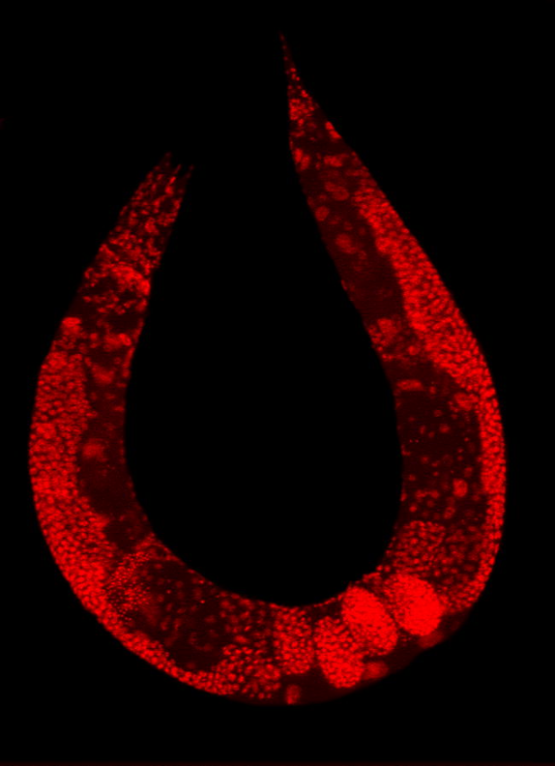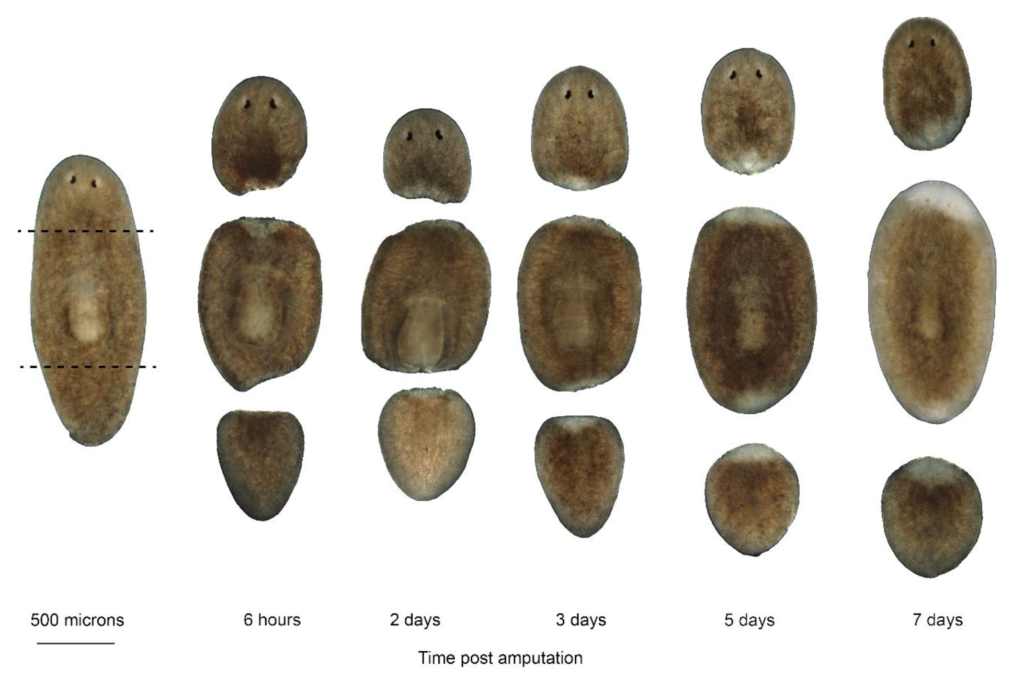Shai-hulud, or the giant sandworm, exists in Dune both as a mode of transportation, a generator of spice, and a key player in the ecological niche of Arrakkis. In the book by Frank Herbert and the movie adaptation (Dune part 1 2021 and Dune part 2 2024 directed by Denis Villenueve), the sandworm plays a key role in the plot. This worm is long and segmented, like an earthworm, but has a mouth with sharp teeth, which kind of resemble a marine bristle worm. Although we don’t have worms several kilometers long matching this description in real life, we do have a great variety of worms. In fact, the worm body plan is the most common body plan of all animals: a bi-symmetrical tube with an opening. In the grand scheme of things, it’s a pretty simple body plan that gets the job done. That’s why there’s so many different worms in our world!
“Nature has provided two great gifts: life and then the diversity of living things, jellyfish and humans, worms and crocodiles” – Theodore Holmes Bullock

Worms come in a variety of types, but I’ll talk about them in three main groups: roundworms, flatworms, and segmented worms.
Roundworms, or nematodes, are the most common type of worm. They aren’t segmented like Shai-hulud, just round and usually small. A lot of nematodes are microscopic, around the length of three human hairs stacked together! They can live in water or soil and are found in almost every type of climate – they can survive in harsh climates because of a protective outer covering called the cuticle. Nematodes have a digestive system that starts with a mouth at one end and an anus at the other end. They have muscle running down the length of their body and a range of sensory capabilities. Some can even detect light – without having eyes!
Flatworms, like their name suggests, are flat instead of round. They have only one opening to take in nutrients and excrete waste. Although some are aquatic, like the gold dotted flatworm in the picture above, some are terrestrial, like the planarian shown above on the right, the shovel headed garden worm. Planarians have two eyes (that see the light just like we do!) and a tube that extends from their body to both take in food and release waste. They have muscles down the length of their body as well as in circles around them which enables them to glide across a surface smoothly. Some types of planarians possess the incredible ability to regenerate – if the shovel headed garden worm is injured, it can regrow the missing pieces!



Segmented worms, like earthworms, have a body plan made up of repeating units called segments. Within each segment is muscle, nerves, intestine, and other important organs. They have a digestive system that’s inside a closed tube in their body. They also have a circulatory system. In addition to earthworms, this category includes marine bristle worms and tube worms. Bristle worms have little hair-like protrusions from their segments that can either function like feet to help them move or like stingers to release toxins into their prey. This is similar to the teeth in Shai-hulud which the Fremen use to make crysknives, their weapon of choice.



“It may be doubted if there are any other animals which have played such an important part in the history of the world as these lowly organized creatures [worms]” – Charles Darwin, The Formation of Vegetable Mould Through the Action of Worms, with Observations on their Habits 1881.
Shai-hulud in Dune shapes the ecosystem of Arrakis through burrowing in the sand, making huge dunes. Part of the emphasis of Shai-hulud in Dune is due to their religious significance – the people of Arrakis recognize the crucial role the sandworm plays in the ecology of the planet. The worms consume sandplankton and after digestion release the most valuable commodity in the world of Dune: spice. They also provide oxygen. Although we don’t have worms that make giant sand dunes, the worms on Earth also play critical roles in our planet’s ecosystems. Earthworms eat plant matter, tiny animals, and other things in the ground to make fertile soil for the environment. Another type of worm, the zombie worm, is great at digesting whale carcasses that fall to the ocean floor. They introduce oxygen into the environment. This provides a nutrient-rich home for a lot of different sea creatures. Other worms aren’t responsible for degrading waste but enter their host to change the behaviors of other creatures.
Many parasitic worms that we normally think are bad for the environment are actually doing more good than harm. Some parasitic worms, like horsehair worms, infect grasshoppers and cause them to enter streams. That enables the worm’s eggs to be laid in the right environment, and the grasshopper provides important nutrients to endangered trout. Additionally, a gut parasite, the whipworm, can infect humans. Scientists in Kuala Lumpur showed that these worm infections were crucial for regulating the bacteria within the human gut. This helped people with IBD or Crohn’s disease.

“If we understand the worm, we understand life” – John Sulston
Because worms have such a simple, easily studied body plan, we can use research on worms to build the foundation for work in other organisms, like humans. For example, C. elegans, a nematode, is a great model for genetic studies – six Nobel laureates have made their award-winning discoveries in C. elegans. This worm always makes the same cells in the same order – as it increases in complexity from fertilized egg to full worm, we know exactly which cells will express certain genes, and become different cell types every time. This faithful pattern has powered many studies on gene inheritance, body plans, cell fate, neuron connections, and developmental diseases. They exhibit behaviors in response to external cues. We can use that to link genes to behaviors and study outcomes of disease or intervention.
Planarians are another type of worm used in research, due to their simple body plan and amazing regenerative capability. These flatworms can make a whole new brain in just seven days. Since they can regenerate their brains, we want to know how they make the right amount of neurons in the right types in the right places. In my research, we study how planarians make new neurons within their brains. So far, my work has found several genes that are important for making new dopamine neurons in planarians. We hope to use this knowledge to uncover the complexity of regeneration in planarians and how this might translate to other organisms.

“You have evolved from worm to man, but much within you is still worm” – Frederich Nietzsche
Because worms have such a simple, easily studied body plan, we can use research on worms to build the foundation for work in other organisms, like humans. When we think about this idea, it also brings up the concept of evolution. The worm body plan is so common – we think it may have arisen multiple times within evolution. That leads us to question what might have been – what have we evolved from? What is the ancestor of animals? Some researchers think it might have been a worm.
The hypothetical ancestor to all animals has been called the Urmetazoan. The name Urmetazoan comes from the prefix -ur meaning earliest/original and the word metazoan, a synonym for animal (in the kingdom Animalia or Metazoa). Because of the commonalities between all living animals, scientists think it was probably a kind of worm-like organism. Most likely, our common ancestor was a single-celled organism, with a single opening to intake nutrients, a digestive system, an anterior-posterior axis, and an outer membrane. Since these squishy organisms were not preserved through the fossil record, we will never know. But, we can still appreciate the worms we have today. When you’re out in nature look near rocks and streams, you’re likely to find some worms. They may not be Shai-hulud, but they are still great little makers.
About the Author
Kendall Clay is a fourth-year Neuroscience PhD candidate in the Roberts-Galbraith lab. She studies genes responsible for the regeneration of dopaminergic neurons in worms called planarians. Her main interests include genetics, disease, and regeneration. Outside of the lab, Kendall enjoys singing, embroidering, and hanging out with her cats, Baby and Sporty. You can contact Kendall at Kendall.clay@uga.edu.
- Kendall Clayhttps://athensscienceobserver.com/author/kendall-clay/March 17, 2022
- Kendall Clayhttps://athensscienceobserver.com/author/kendall-clay/








